Colder weather calls for warmer, more comforting food. Food that sticks to your ribs, as they say. Well, there’s not much that is more comforting than beef brisket, and there’s not a much more rib-sticking method of cooking than the confit method. So this fall, maybe eat some beef that’s been slow-cooked in fat. Make Brisket confit. You won’t regret it.
Confit of beef brisket is a sumptuous, meaty gem that sticks to your ribs and is perfect for changing seasons and cold winter nights. It adds a touch of indulgence to a long dark night. Take a twist on tradition and shred it onto a salad, or do one better and go main course with this hearty polenta underneath it. The cold weather will look more promising with this dinner under your belt; and with a good thermometer, you can be sure your results will make for a memorable meal.
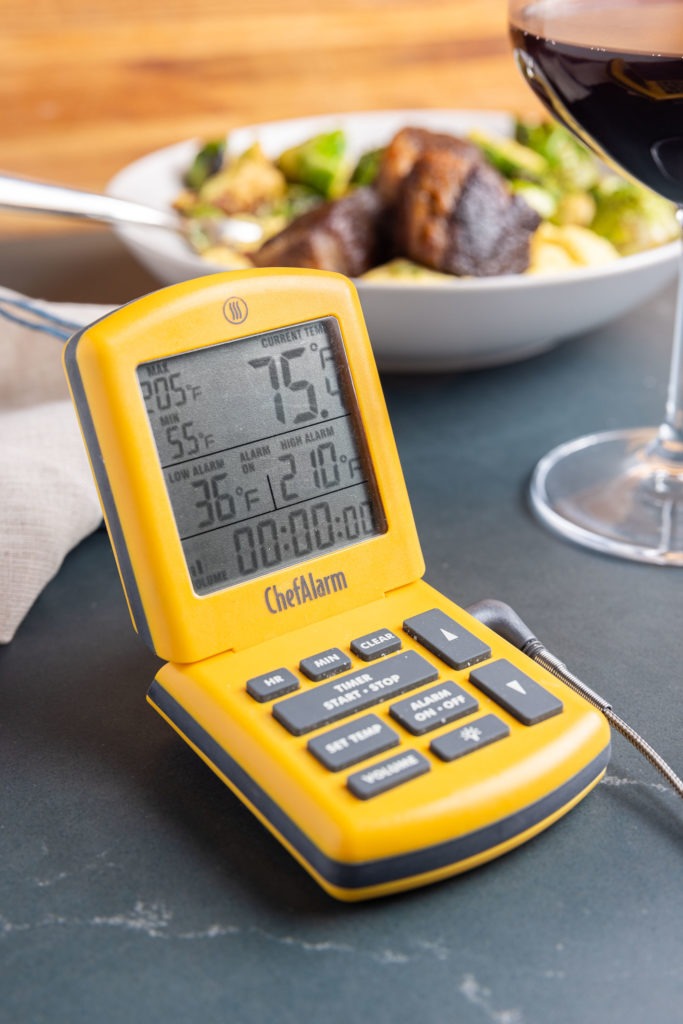
Contents:
Confit: what is it?
“Confit” is a French term that has taken on the meaning “preserve.” It comes from the old French confire, to prepare (and, by extension, to preserve), and refers to the origins of this method of cookery. “Confit” was a means of preserving foods in an age before refrigeration. The most famous of confits, duck confit, was made by slowly cooking lightly cured duck legs in rendered duck fat, and then storing the cooked legs in the fat. The congealed fat would create an oxygen and bacterial barrier that would allow the duck to be kept for months, if not longer, before spoiling.
Today, people make confit more often for flavor than for preservation, but it is still nice to remember where this dish comes from and carry some of that weight of history into our cooking.
Why cook in fat?
Some may look at the confit method and wonder if cooking slowly in fat is necessary. It is.
Melted fat, or oil, provides a constant-contact medium for heat exchange that is nonetheless unable to absorb any water-soluble flavors or juices from the meat. Flavor is retained in the meat, rather than sucked from it (which happens when meat is boiled). But the method doesn’t just preserve water-soluble flavors, it also adds a benefit in regard to oil-soluble flavors: the thyme, pepper, and allspice, all have oil-soluble flavors that will mingle with and permeate the oil bath, creating a potently seasoned cooking pot for your food.
We cooked our brisket confit in beef tallow that we rendered from our last couple of brisket cooks. If you don’t have that, feel free to use another fat or oil.
Isn’t this just deep frying?
Why don’t we just call this deep frying? For the same reason we don’t call barbecue grilling: this is a low, slow procedure intended for well-done yet still-tender results. One of the main goals of deep frying is dehydration—crisping up a batter or an external layer. In the confit method, we are looking for water retention, not evaporation. Maintaining an oil temperature well below the boiling point helps us retain as much moisture as possible, and a good thermometer is key for maintaining those temps over time.
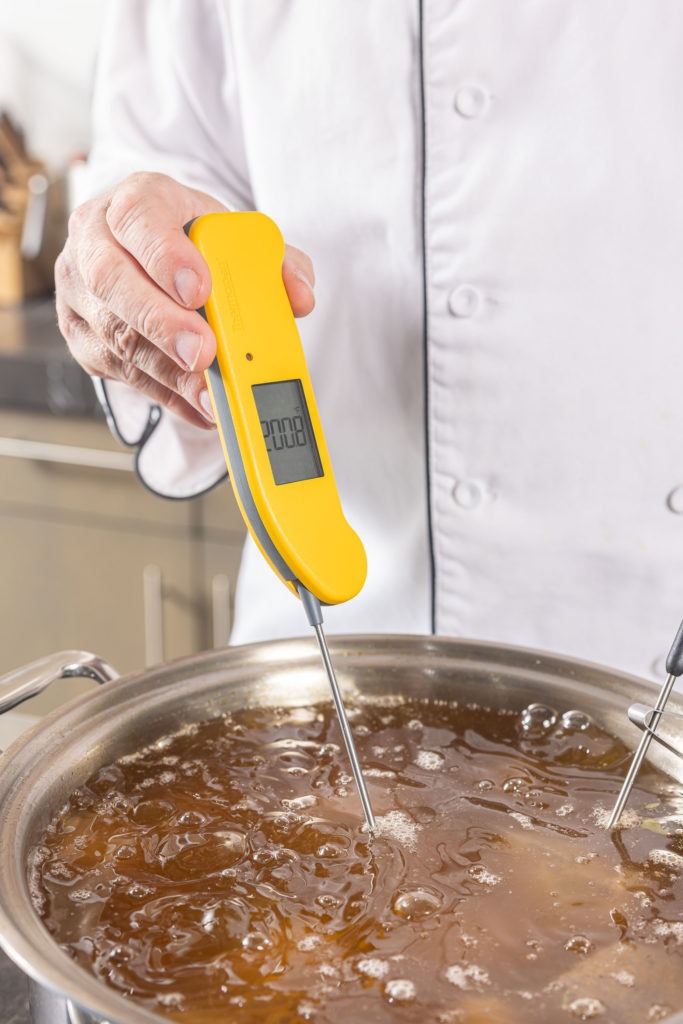
How to make meat confit
Meat selection
Thermally speaking, the confit process is very similar to barbecue. The low, slow heat is ideal for melting collagen into gelatin, and the moisture-sealing properties of the oil help the meat stay juicy (if the oil doesn’t get too hot). In addition to the qualities of the method itself, everything that makes brisket into amazing barbecue will make it into amazing confit: flavor, collagen that can break down, fatty goodness. It’s a recipe for deliciousness. So, you generally want to choose meats like goose, duck, pork shoulder or, in this case, brisket that are rich in connective tissue.
Oil selection
The fact that oil is really important to the confit process doesn’t mean that you have to go full-traditional and cook your food in the fat of the same animal, if that idea bothers you. Any rendered fat or oil will do. But keep in mind the flavor of your desired end product. We don’t recommend using rendered beef fat for pork confit! But lots of flavors work well with each other; Bon Appétit even gives a recipe for olive oil chicken confit.
Cure it
While Escoffier famously made confit of potatoes, we will limit ourselves in this post to meat. And the first step in making a meat confit (be it duck, lamb, beef, etc.) is to cure it. A simple overnight salt cure will do. This prepares the meat for preservation by starting to work on the bacteria on the surface of your meat. Salt kills bacteria with great efficiency, so salting meat was an important first step in preserving it.
But beyond the preservation aspect of salting, curing adds a lot of flavor. In addition to salt, our cure can have a mixture of seasonings, spices, and herbs according to our end-flavor goals. Thyme is often used, bay leaves, and allspice, too. Fresh garlic is a great addition to any confit cure. All these are used to coat the meat as it is left in the refrigerator overnight to cure. The next day, it is lightly rinsed and then braised in fat.
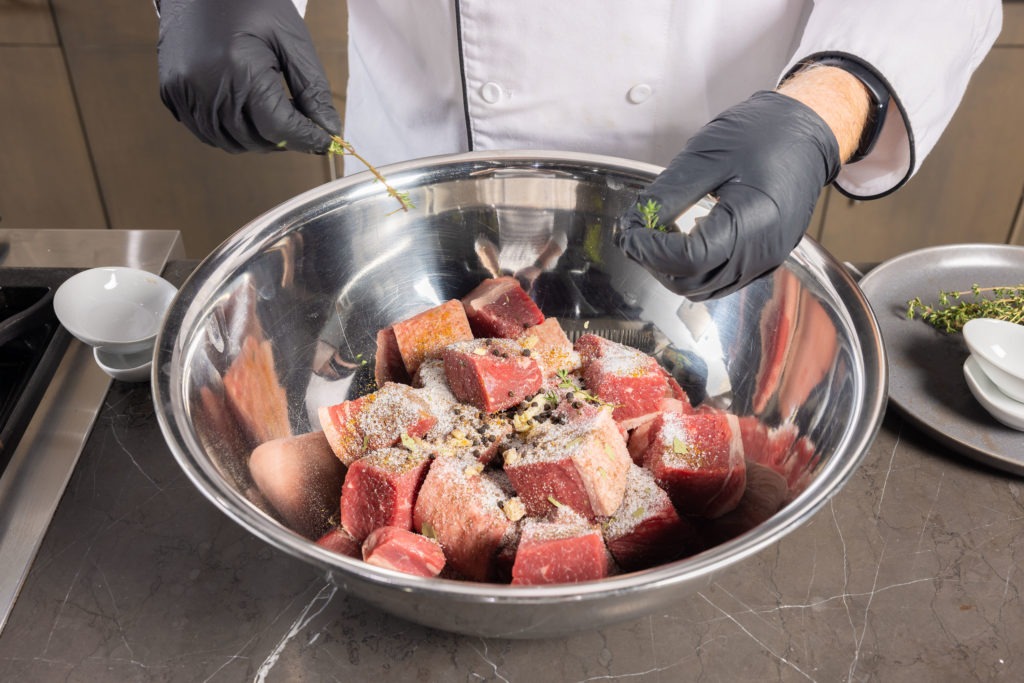
Slow cook it
When the meat is done curing, melt fat—or pour oil—into a Dutch oven or other large pot that can accommodate all the meat. If you’re cooking legs of fowl, use something that can hold them all in one layer, but chunks of other meats can handle some stacking.
Maintaining a steady temperature in your oil is critical to your success. If the oil temperature drops, the collagen takes too long to break down. If you allow the temperature to spike even a little, the water in the meat can boil out, leaving tough, dry brisket. For this reason, we heat the fat to a good cooking temperature, about 200°F (93°C) before moving the pot with the meat to an oven set to 225°F (107°C). The temperature may increase slowly over time, but it will not spike and ruin the meat. It will take several hours for the meat to cook in this gentle heat, and the meat will become tender and shreddy during that time.
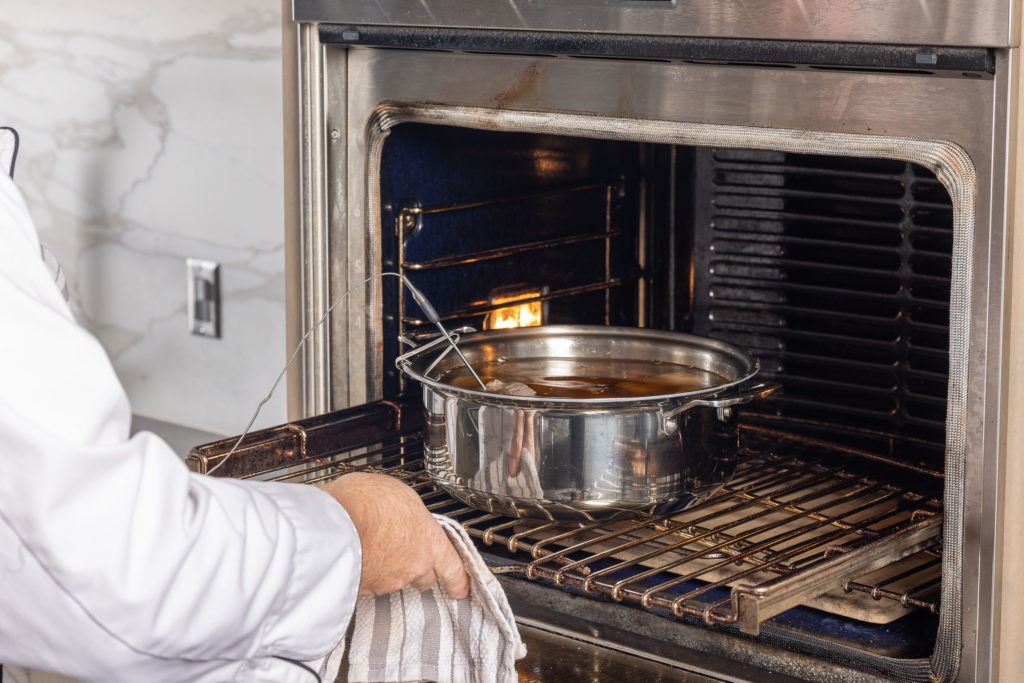
Cook to tender
The small chunks of brisket will reach the temperature of the oil, around 190°F (88°C) in only a few hours, but the collagen in the brisket needs time to unwind into moist gelatin.
An accurate and easily readable thermometer is key for this part of the operation, like our ChefAlarm®. With high- and low-temp alarms, and compatibility with all Pro-Series® probes, ChefAlarm makes monitoring long cooks like this one a breeze.
We set our ChefAlarm high-temp alarm for 203°F (95°C) and put the end of the probe in one of the largest chunks of brisket. Then we set a timer for 3 hours once that temperature is reached. You can check the tenderness periodically during that time, feeling for tenderness. If it needs more time to tenderize, so be it, but it should be nearly done by then. Smaller cubes will cook more quickly.
Store it (optional, but recommended)
The final step in confit cooking is storing. Allow the fat to cool and transfer the meat and fat to a storage container. Store the meat in your refrigerator or another cold place for up to several weeks. (If you’ve used a rendered fat, it will resolidify in the fridge.) It can absolutely be eaten as soon as it is done cooking, but if you have the time, store it for a day or two and try it then. The flavors will come together even more, and the preservation experience of it will be well worthwhile.
Searing brisket confit
Because we cook the confit at the slow, gentle temperature that we do, it doesn’t really brown. Yes, it turns grey, but there is no beautiful, beefy crust on it. To remedy this, sear each piece on all sides in a pan before serving. Because the proteins on the surface area are already cooked, they browns quickly and beautifully, imparting that delicious seared-beef flavor.
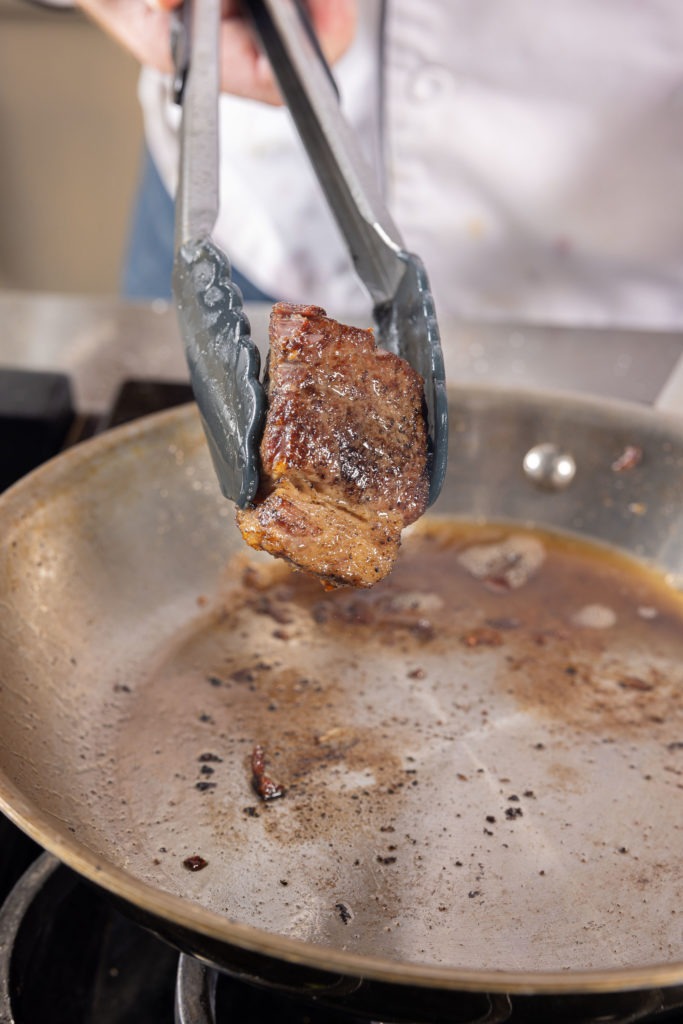
Confit of beef brisket is a great, hearty way to serve this beloved cut of meat. Give this warm, comforting dish a try, and let your ChefAlarm guide you to success.
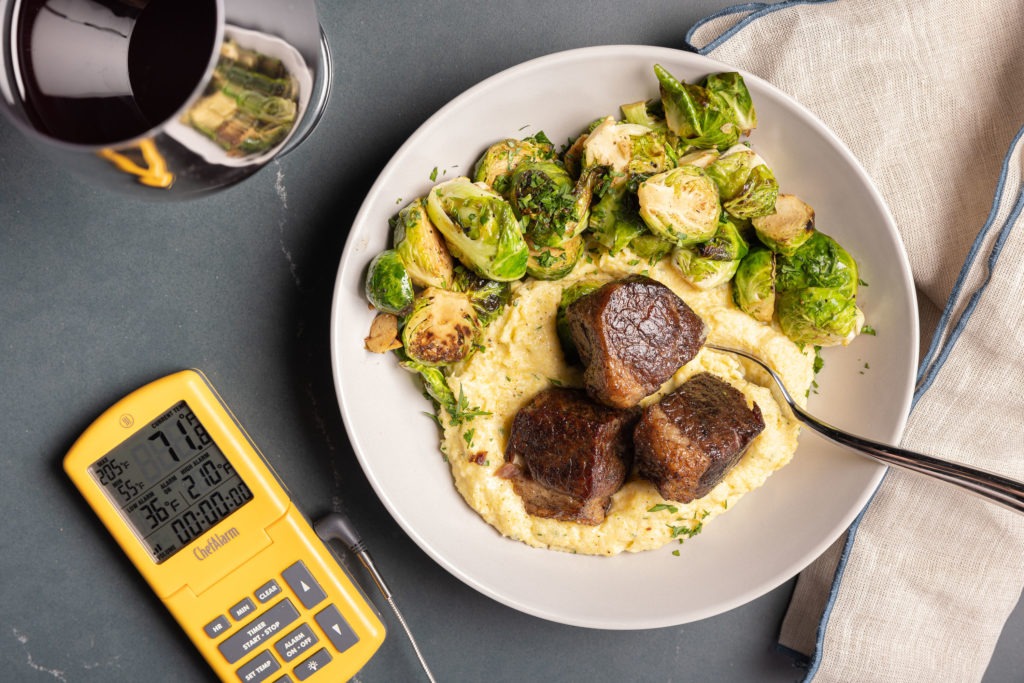

Confit of Beef Brisket Recipe with Goat Cheese Polenta
Description
Slow-cooked brisket with rich goat-cheese polenta underneath.
Ingredients
For the brisket confit:
- 3 lb brisket flat, cut into 2” cubes
- 4 tsp kosher salt
- 1 tsp black pepper
- ½ tsp allspice
- 1/4 tsp ground mace
- 5 good sprigs fresh thyme
- ¼ tsp paprika (smoked, if you like)
- 4 bay leaves, crumbled
- 4 cloves garlic, crushed and roughly chopped
- enough light olive oil or rendered fat to cover the meat, about 1 1/2 quarts—we used rendered brisket fat
For polenta:
- 1/2 cup dried polenta or cornmeal
- 1 1/2 cups water
- 1/2 cup half-and-half
- 4 oz fresh goat cheese (chevre)
- 1 Tbsp butter
- 2 tsp fresh minced parsley
- Salt to taste
Instructions
Day before cooking:
- Cut brisket into short-rib sized chunks—about 2″ square.
- Combine salt and dried spices. Toss spice mixture, garlic, fresh thyme, and bay leaves together with beef.
- Place in refrigerator uncovered overnight to cure.
Day of cooking:
Make the confit
- Preheat your oven to 225°F (107°C).
- Lightly rinse the excess salt and spices off the meat, reserving the bay leaves, thyme sprigs, and garlic to add to the oil with the meat.
- Heat the oil/fat in a sauté pan or dutch oven large enough to hold the meat comfortably.
- Heat the oil to 200°F (93°C) (verified on your ChefAlarm or with your Thermapen ONE.)
- Add the meat to the oil. If, after all the meat is added, the oil doesn’t cover the meat, add more fat or oil until the meat is submerged.
- Insert a probe into one of the largest pieces of meat, using a pot clip to keep the probe from falling into the hot oil.
- Adding meat to the oil will make the temperature drop dramatically. Heat it some more to bring it back up to 200°F (93°C).
- Place the pot in the oven, running the probe cord out the door to your ChefAlarm.
- Set the high-temp alarm on your Chef Alarm for 203°F (95°C). Cook.
- When the alarm sounds, set a timer for 3 hours. Check the tenderness after that timer sounds.
- If tender, remove the pot from the oven, otherwise cook for another half hour and check again.
- Either let the pot cool, covered, on the counter, until it can be stored in the refrigerator, or serve the meat right away.
- Before serving the meat, brown the cubes in some of the reserved fat in a pan.
To make the polenta:
- When the confit is nearly finished, combine the half-and-half, salt, and water in a small saucepan. Bring to a boil.
- Add the cornmeal while whisking. Cook over medium-high heat, stirring often.
- When the polenta thickens, turn down the heat and continue to stir, scraping the edges and bottom of the pan.
- When the polenta is thick and starts to pull away from the edge of the pan, turn off the heat.
- Add the goat cheese and the parsley and stir to combine.

- Add the butter and stir to combine. This will give the polenta a nice glossy sheen.
Serve the confit on a bed of polenta, and rejoice in the warmth of cold-weather food.
Shop now for products used in this post:
References:
Tom Colicchio, Duck Confit, on Epicurious.com
Claire Saffitz, Olive Oil–Confit Chicken with Cipolline Onions, in Bon Appétit
J. Kenji López-Alt, What the Heck is Confit?, on SeriousEats.com
Michael Ruhlman and Brian Polcyn, Charcuterie
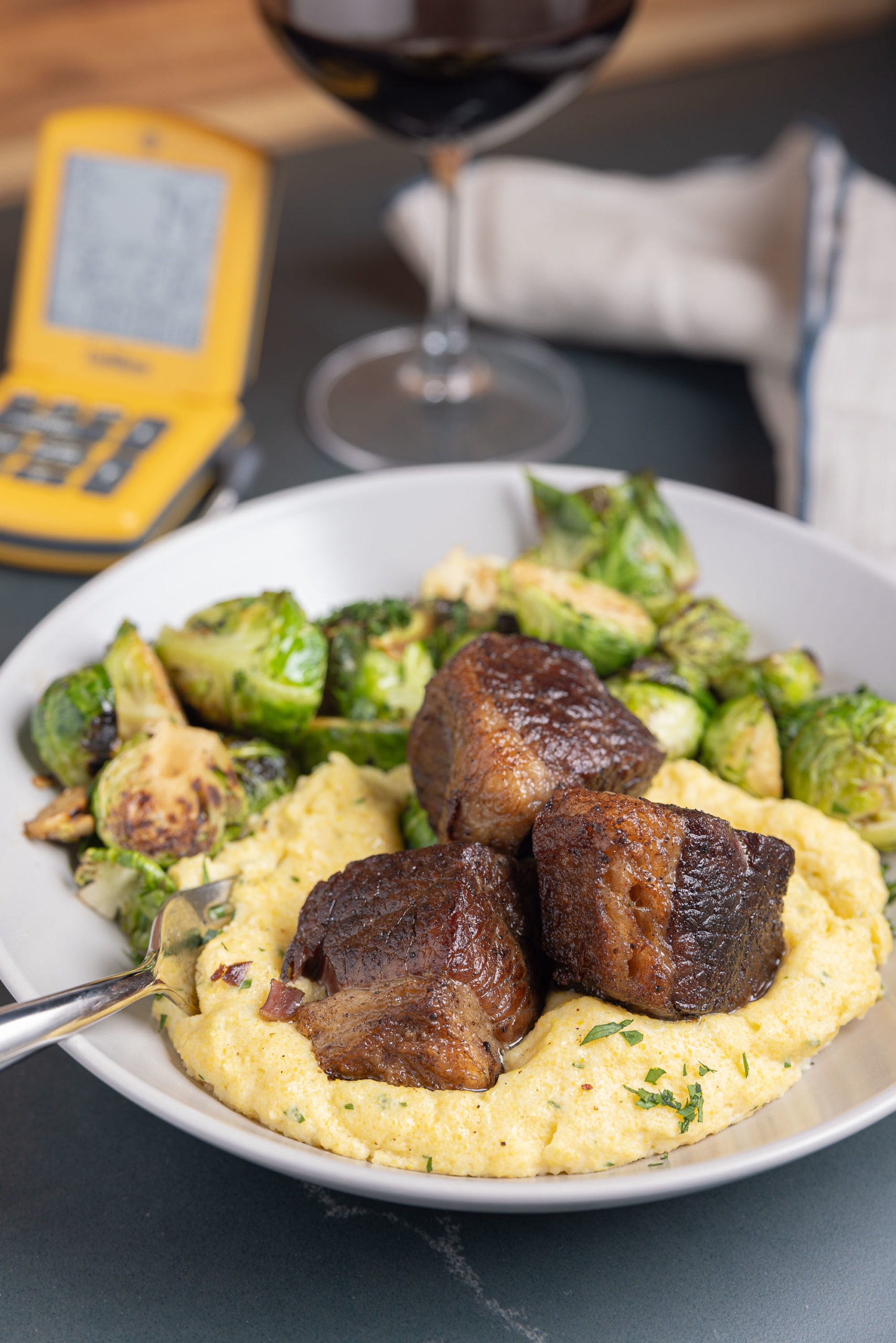
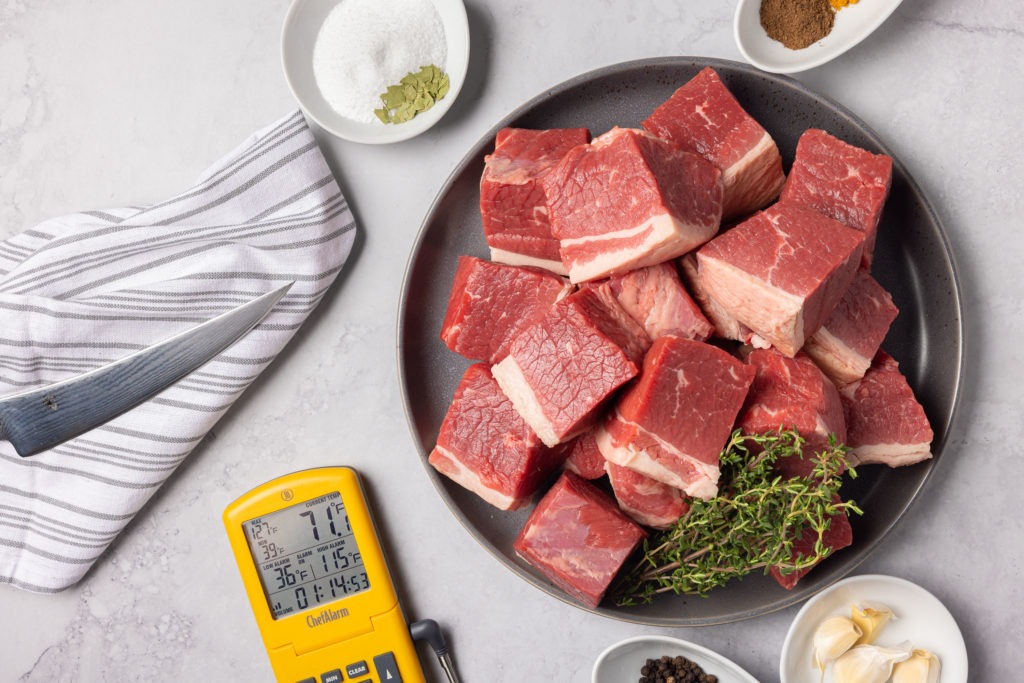
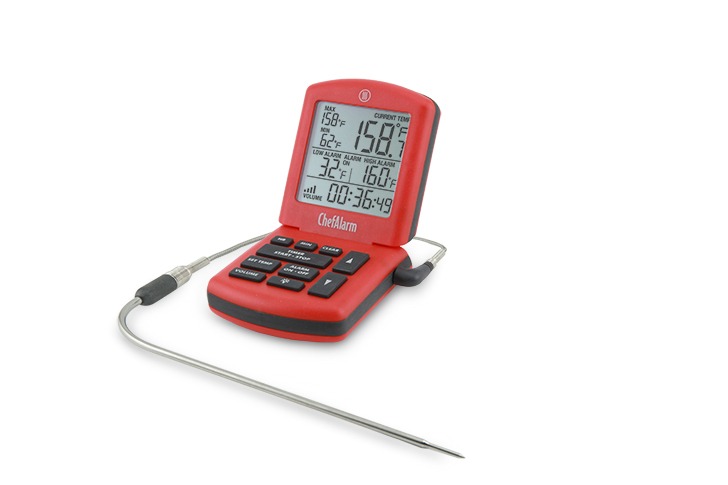

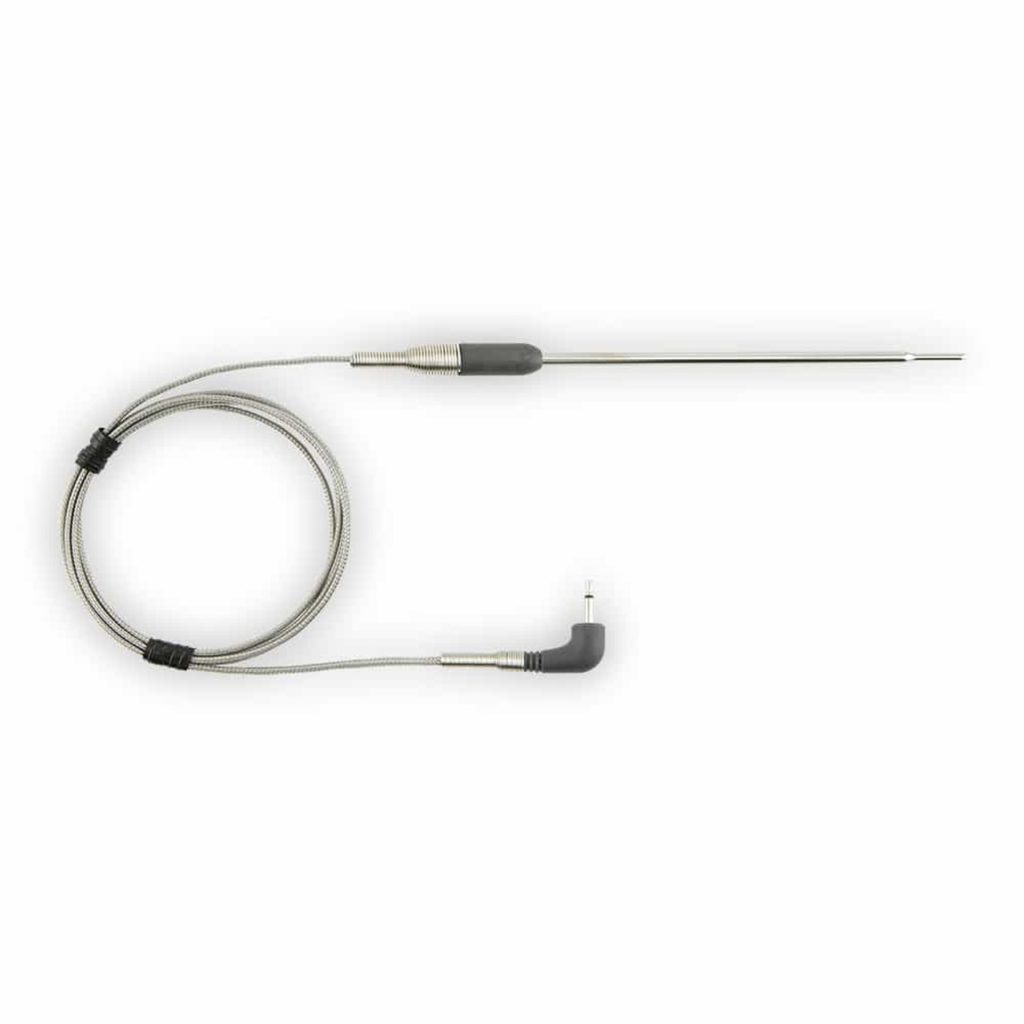

Pete H says
I was particularly interested in your admonition to not let the meat get above the boiling point of water lest it dries out. It might be useful to point out that the boiling point decreases as one goes up in altitude. For example, in Denver, the mile-high city, water boils at 201 degrees Fahrenheit, not 212 as it does at sea level. In Leadville, Colorado’s highest town at 10,000 feet, the boiling point is 193 degrees.
Martin says
Pete,
Excellent point! We even have tool for that. Behold: the ThermoWorks Boiling Point Calculator!
David Frederick says
Any reason you couldn’t use a slow cooker?
Martin says
David,
I honestly hadn’t considered this option. If you were to do it, you’d need to make sure your slow-cooker operated within the correct temperature range. MINE only says “high” and “low,” so I’d first check what those mean. Otherwise, great idea!
J-Man 50 says
It would be nice if you would indicate the number of servings this produces.
Martin says
J-Man,
This produces about 7 servings. My bad for not including that information!
Chris says
Why not bring the oil up to 200 degrees and then put into a 200 degree oven? That would eliminate the need for much oil monitoring.
Martin says
Chris,
See my answer to Samer also in these comments. Thanks for reading!
Samer Abraham says
Why on the stove instead of oven?
Martin says
Samer,
Honestly, you could probably do it that way. Just make sure your oven is maintaining a proper temp, not overcooking the meat. I used a Smoke the other day at home to check my oven temp and found it to be 49°F higher than stated. If you know your oven’s state, go for it. If not, stove-top flames are easier and faster to adjust than ovens are,and that is something to be aware of.
rsohn says
To maintain temps, can’t the oil/brisket go into a sous vide bag?
Martin says
Rob,
As Modernist Cuisine has shown, making confit in a Sous Vide bath is very effective, and if you have a circulator, go for it! I (*hides face in shame*) don’t have one at home yet.
bill Marshall says
I have made Duck Confit many times in the past. Never thought about beef brisket. So i had a party on New Years Eve. Had 24 people over. so i made two beef confit. On using a Brisket Flat and used shortening with a little lard and the other was done in beef tallow i had in my pantry.
The brisket flat done in the Beef Tallow was absolutely breathtaking!!!!!!
I made the confit on Friday morning and served it at 11pm on Sunday.
Thank you for making this an easy cook!
Martin says
Bill,
So glad to hear it! Thanks for sharing your success with us!
Eric L. Peters says
This looks like it could be made with a sous-vide.
Martin says
Eric,
Yes, as I commented to Rob, this certainly can be done sous vide, if you have that technology!
Eric L. Peters says
Thanks!
Toliver says
I assume you are using the flat of the brisket for this recipe, correct?
Martin says
Yes, that is correct! Other brisket parts will work also, but do separate the point from the flat before cooking in this case.
Jack says
If you are storing the confit, how do you reheat it best ?? I see the comment about being sure to crisp the reheated brisketbut what is the step prior to that?? Just reheat confit & cooking fat in a sauce pan??
Martin says
Jack,
Yes, reheating it in a saucepan is a great way to do it. An oven at ~300°F is a good way, too, but then crisp it under a broiler or in a pan with its own fat.
Armand says
Could you freeze what you don’t use immediately?
If so, any tips on defrosting and reheating?
Martin says
Yes, you could. the very best way to reheat would be by sous vide. Defrost slowly in the fridge.
Annie says
So once the meat gets to 203, then set the timer for 3 hours? How long does it typically take for the meat to get to that temp?
Martin says
It takes a couple hours, also. So this isn’t a fast cook, but it is very tasty!
Jacqueline says
You instruct to crumble Bay Leaves in dry rub mix which is later rinsed off; saving thyme sprigs, garlic and bay leaves to add to hot-fat cook. How do you accomplish collecting all the crumbled Bay leaf pieces? Thyme twigs and smashed garlic I could recollect but bits of Bay leaf seems time consuming or impossible. Would rinsing off the leaves with other spices, (capturing twigs and bulbs – no problem), then adding another fresh Bay Leaf to the confit cook, work? Yes, I hate to waste any spices due to cost but I could go crazy attempting to locate crumble pieces.
Martin says
Fair point. I think what I meant was to break the bay leaf into pieces, but leaving them whole will do.
Heather says
Happy to have found your recipe; I have a moose roast in the freezer that I’m hoping to use in your recipe to slightly replicate a fondue I had in the 60s when I was around 5. I never forgot that little pot of olive oil and garlic cloves cooking those chunks of moose to garlicky oily perfection.